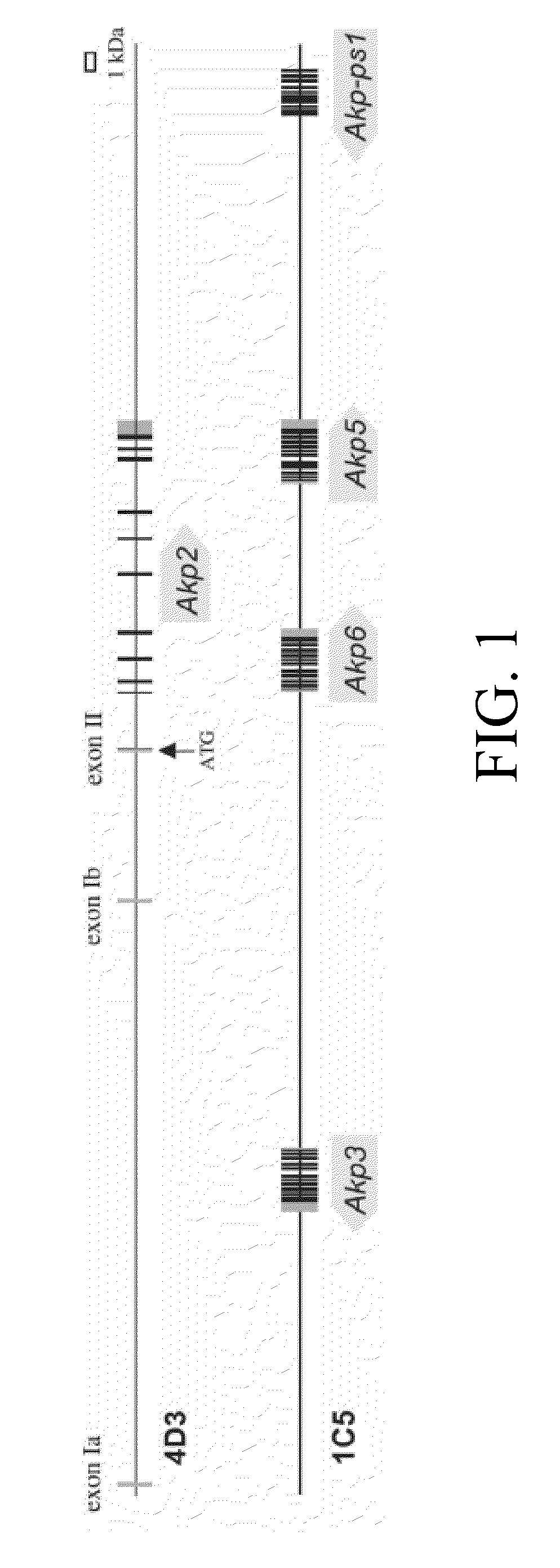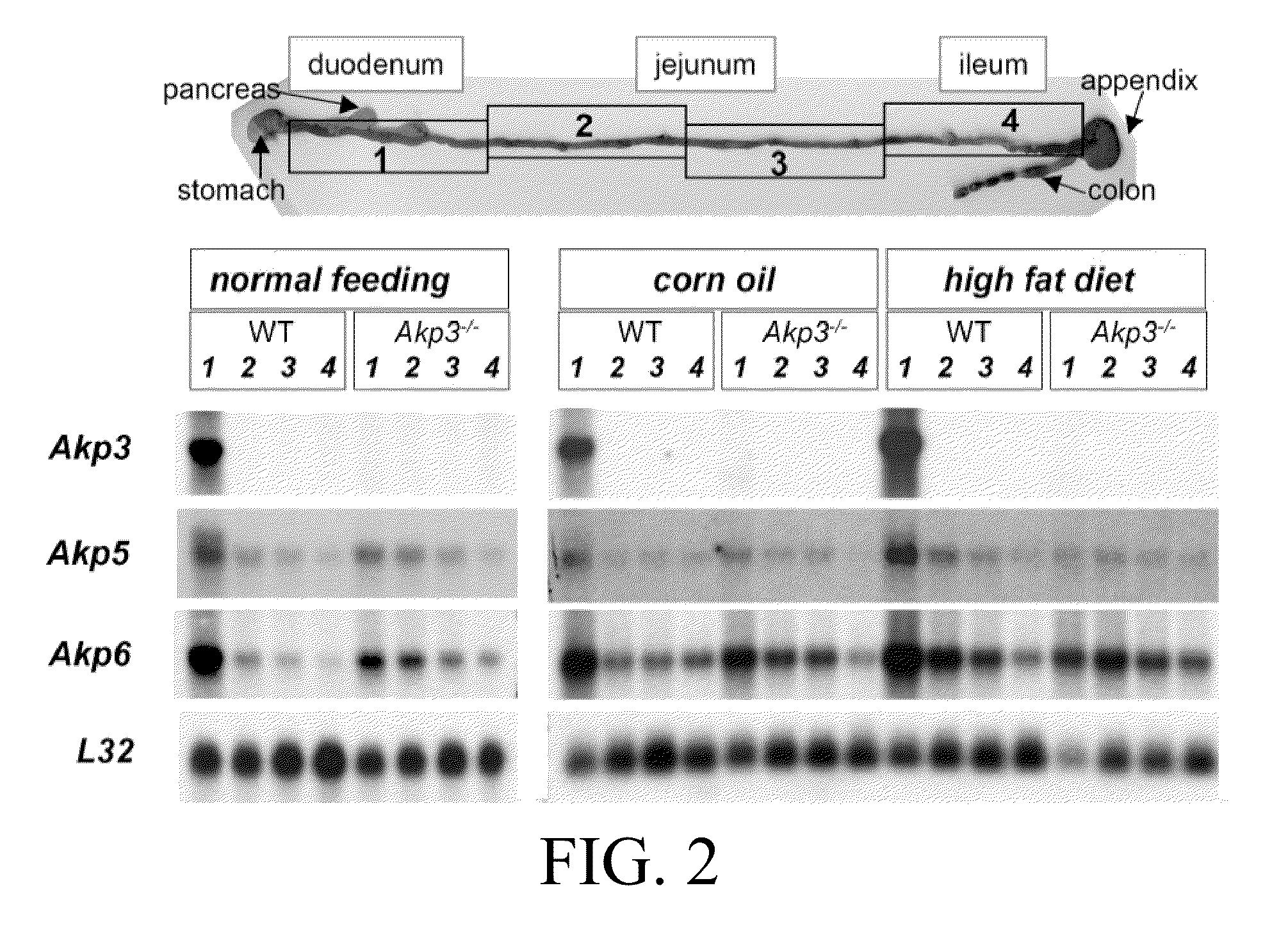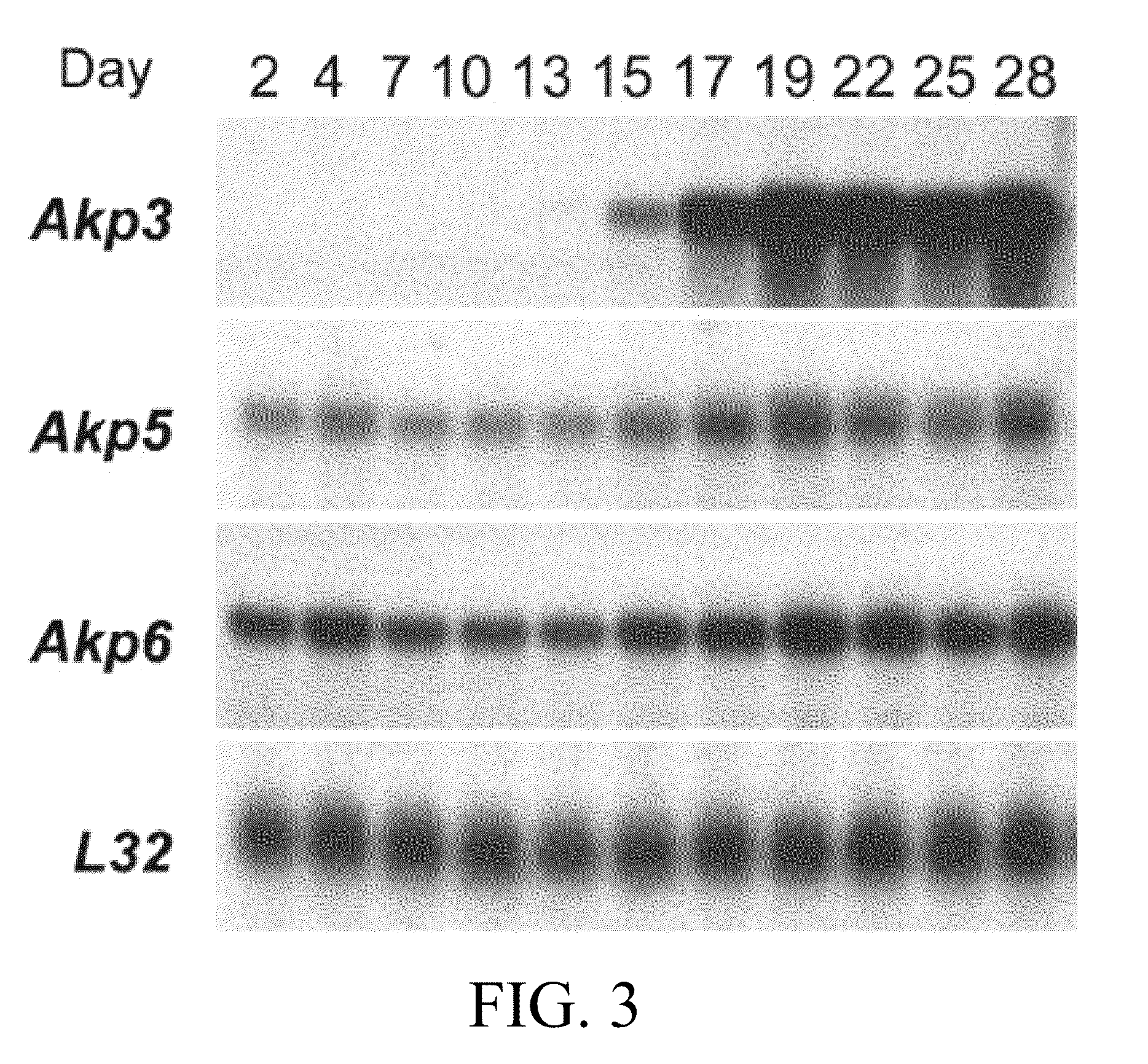Intestinal alkaline phosphatase modulators and uses thereof
a technology of alkaline phosphatase and modulator, which is applied in the field of modulators, can solve the problems of morbidity and even mortality, severe consequences of gut mucosa damage, and severe impairment of gut mucosa, and achieve the effects of suppressing bacterial colonization in the gut, suppressing gut mucosal atrophy, and increasing fat absorption
- Summary
- Abstract
- Description
- Claims
- Application Information
AI Technical Summary
Benefits of technology
Problems solved by technology
Method used
Image
Examples
example 1
1. Example 1
Akp6 is Upregulated in Intestines of Akp3 Knockout Mice
[0720]The epithelium of the mouse small intestine expresses two intestine specific AP genes, Akp3 and Akp6, and low levels of Akp5, which is not intestine specific (Narisawa, et al, 2007). The genomic organization of these genes are shown in FIG. 1. AP proteins encoded by Akp3, Akp5 and Akp6 were designated duodenal IAP or dIAP, embryonic AP or EAP and global IAP or gIAP, respectively. The peptide sequences of dIAP and gIAP have 87% homology, while EAP shows slightly lower sequence similarity to the others. Kinetics studies with recombinant proteins encoded by the three genes indicated that dIAP had the highest Km value and appeared to be the most efficient enzyme at least in vitro using the artificial substrate, p-nitrophenyl phosphate (pNPP), at alkaline pH (Table 2).
TABLE 2Kinetic parameters of recombinant mouse dIAP, gIAP,and EAP using p-NPP as a substrate at pH 9.8.Isozymekcat, s−1Km, mMkcat / Km, s−1 · M−1dIAP339...
example 2
2. Example 2
Intestinal Alkaline Phosphatase is a Gut Mucosal Defense Factor Maintained by Enteral Nutrition
[0723]i. Effect of IAP Expression on LPS Signaling in Cells Over Expressing Recombinant IAP
[0724]To assess the role of IAP in the intestinal barrier system against bacteria, stably-transfected intestinal cell lines expressing recombinant human IAP were produced. When parental cells (colorectal cancer cell line, HT-29) expressing no IAP were exposed to LPS, the LPS signaling was activated and the Rel / p65 complex was translocated to the nucleus, while the signaling was blocked in the transformant cells overexpressing IAP (FIG. 5A). A rat intestinal cell line IEC-6 and IEC-6 cells over expressing IAP were transfected with a firefly luciferase reporter gene under control of a NF-κB response element together with a normalizing plasmid expressing Renilla luciferase (Dual-Luciferase Reporter System, Promega). Exposure of cells to various LPS concentrations activated the firefly lucife...
example 3
3. Example 3
Screening Comprehensive Chemical Libraries to Identify Small Molecules that Specifically Modulate IAP's Enzymatic Activity
[0729]i. Methods
[0730]a. Production of Enzymes.
[0731]An expression vector pCMV-Script containing cDNA for human IAP, TNAP, PLAP, GCAP, mouse TNAP, dIAP, EAP or gIAP in secreted form (FLAG-tagged) is transfected into COS-1 cells for transient expression using a standard electroporation method. The GPI anchoring site is replaced by a FLAG sequence to make the proteins secreted into the media as well as to test their kinetics in a form immobilized by anti-FLAG antibody (Narisawa, et al, 2007). Medium is changed to serum free medium Opti-MEM (Invitrogen) 24 h later, and media containing secreted proteins was collected 66 hr after electroporation. Conditioned medium filtered by a 2 μm cellulose acetate membrane is supplemented with 0.1% BSA, aliquotted and stored at −80° C.
[0732]Human IAP is produced on a large scale to be used in the primary high throughp...
PUM
| Property | Measurement | Unit |
|---|---|---|
| size | aaaaa | aaaaa |
| diameters | aaaaa | aaaaa |
| diameters | aaaaa | aaaaa |
Abstract
Description
Claims
Application Information
 Login to View More
Login to View More - R&D
- Intellectual Property
- Life Sciences
- Materials
- Tech Scout
- Unparalleled Data Quality
- Higher Quality Content
- 60% Fewer Hallucinations
Browse by: Latest US Patents, China's latest patents, Technical Efficacy Thesaurus, Application Domain, Technology Topic, Popular Technical Reports.
© 2025 PatSnap. All rights reserved.Legal|Privacy policy|Modern Slavery Act Transparency Statement|Sitemap|About US| Contact US: help@patsnap.com



